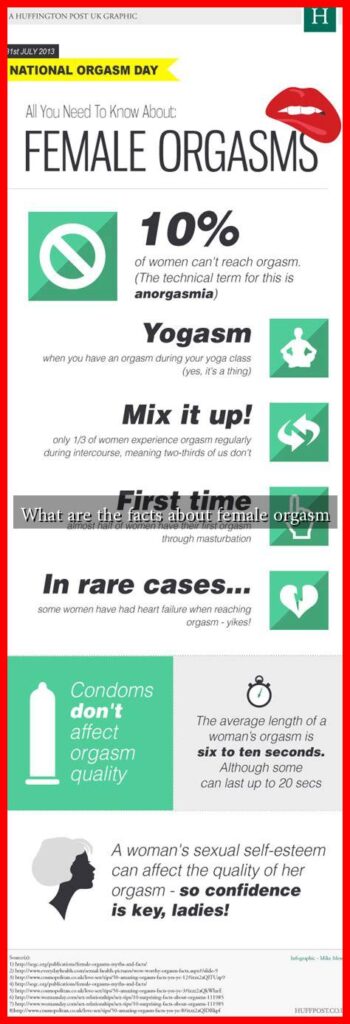-
Table of Contents
What Are the Facts About Female Orgasm?
The female orgasm is a complex and often misunderstood phenomenon. Despite the wealth of information available, many myths and misconceptions persist. Understanding the facts about female orgasm can empower women and enhance sexual health and relationships. This article delves into the science, psychology, and cultural aspects of female orgasm, providing a comprehensive overview of what we know.
The Science of Female Orgasm
Female orgasm is defined as the peak of sexual arousal, characterized by intense pleasure and the release of sexual tension. Scientifically, it involves a series of physiological changes:
- Muscle Contractions: During orgasm, the pelvic floor muscles contract rhythmically, which can last from a few seconds to over a minute.
- Increased Heart Rate: Heart rate and blood pressure typically rise, contributing to the overall feeling of excitement.
- Hormonal Release: Orgasm triggers the release of hormones such as oxytocin and endorphins, which promote feelings of happiness and bonding.
Research indicates that the female orgasm can occur through various forms of stimulation, including clitoral, vaginal, and even anal stimulation. A study published in the Journal of Sexual Medicine found that approximately 75% of women reported achieving orgasm through clitoral stimulation, while only about 25% reported vaginal orgasms.
Psychological Factors Influencing Orgasm
Psychological factors play a significant role in a woman’s ability to achieve orgasm. These include:
- Emotional Connection: Many women report that a strong emotional bond with their partner enhances their sexual experience and likelihood of orgasm.
- Stress and Anxiety: High levels of stress or anxiety can inhibit sexual arousal and orgasm. A relaxed state is often necessary for orgasm to occur.
- Body Image: Women who feel positive about their bodies are more likely to experience orgasm. Negative body image can lead to self-consciousness during sexual activity.
Understanding these psychological factors can help women and their partners create a more conducive environment for sexual pleasure.
Cultural Perspectives on Female Orgasm
Cultural attitudes towards female sexuality and orgasm vary widely across the globe. In some cultures, female pleasure is celebrated, while in others, it is stigmatized. This cultural context can significantly impact a woman’s sexual experiences:
- Education and Awareness: In cultures where sexual education is lacking, women may have limited knowledge about their bodies and sexual pleasure, leading to difficulties in achieving orgasm.
- Taboos and Stigmas: Societal taboos surrounding female sexuality can create feelings of shame or guilt, which may inhibit sexual enjoyment and orgasm.
- Empowerment Movements: Recent movements advocating for women’s sexual rights have begun to challenge these taboos, promoting open discussions about female pleasure.
For instance, the rise of sex-positive feminism has encouraged women to explore their sexuality without shame, leading to increased awareness and acceptance of female orgasm.
Statistics and Case Studies
Statistics reveal significant disparities in orgasm rates between men and women. According to a study published in the Archives of Sexual Behavior, approximately 95% of men reported having experienced orgasm during their last sexual encounter, compared to only 65% of women. This gap highlights the need for better communication and understanding between partners.
Case studies also illustrate the importance of education and communication. For example, a couple who participated in a sexual wellness workshop reported that learning about female anatomy and pleasure significantly improved their sexual experiences, leading to more frequent orgasms for the woman.
Conclusion
Understanding the facts about female orgasm is crucial for enhancing sexual health and relationships. The interplay of physiological, psychological, and cultural factors shapes women’s experiences of orgasm. By fostering open communication, promoting sexual education, and challenging societal taboos, we can create a more inclusive and empowering environment for women’s sexual pleasure. Ultimately, knowledge is power, and understanding the complexities of female orgasm can lead to more fulfilling sexual experiences for all.




